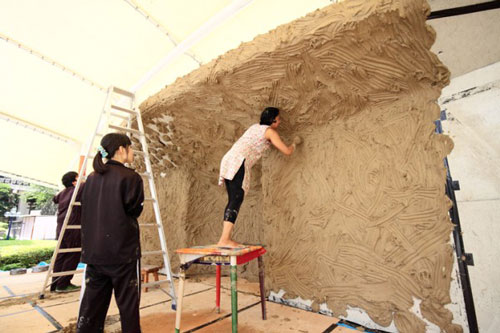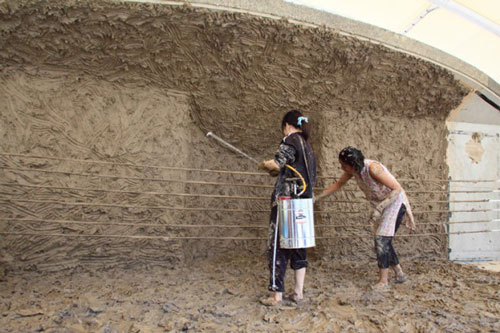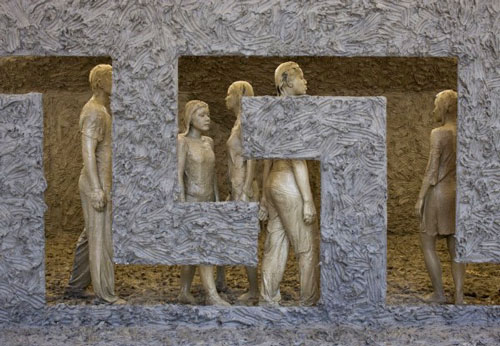Two Performances by Anindita Dutta at Fukuoka Asian Art Museum, Kyushu, Japan
by KANAE HASEGAWA
Anindita Dutta. Performance 1. Wrest in Peace.
Clay was the main cast in two performances presented by Indian artist Anindita Dutta in which the artist orchestrated performers coated with clay from top to toe to perform against a backdrop equally covered with soil. The performances were part of Dutta’s artist-in-residency programme at Fukuoka Asian Art Museum in Kyushu Island, which lies southwest of the main Japanese Archipelago.
Building up the performance started on an extremely hot day with the temperature reaching 33C. The artist took nearly 1000 kg of soil from the local area and mixed with water she started to take handfuls of clay and apply it to the open-air stage. Watching the artist laboriously build up this stage with kilos of clay from the floor to the roof like a grotto for nearly three hours was in itself a performance.
The first performance began with two amateur actors all dipped in clay in the act. As a man and a woman, walking over the floor covered with clay, they sat at the table facing each other and slowly started hand-wrestling. The performers faces showed no sign of emotion, almost lifeless; what the audience saw was their physical body surface covered with clay with very little drama going on. But the visual impact of clay dominated the performance, which was serene and sublime.
Anindita Dutta. Performance 2. A Mazing, 2010.
Clay has been an essential part of Anindita Dutta’s artwork. Academically trained as a sculptor and coming from a small town Purnia in the north of India, close to the border of Nepal, clay or soil was a part of her living environment, and the material was a natural choice for the artist to work with.
“Clay is a direct medium. I can express my feelings right away without having to wait for the post- processing of the material. I can transfer my energy, deep thoughts easily through textures on clay. It is a medium close to my heart.” She loves playing with the material and kneading it with both hands. “I am a tactile person. If I am interested in something, I cannot help touching it, feeling it. You will be surprised to know how malleable clay is. Besides, clay is universal. It comes from our mother earth, everyone in their childhood memory has at least once played with clay. You can find clay anywhere in the world, in any region, but each lump of clay speaks so much about itself.”

Anindita Dutta. Doroing (Doro - clay in Japanese). Applying the clay to the stage backdrop. Courtesy Anindita Dutta.
As Anindita mentions, indeed, the colour, the texture, the density of the sand, clay can show extensive diversity even taken from just one island. In Japan, in one of small islands in the Pacific sea, you can have about 600 different colour tones in clay.
Individually as the clay exists, at the same time, clay can homogenise uniformly for different objects. Once you cover the human body with clay, it is as if this human life disappears and the human substance becomes like a statuette. That is why the audiences who happened to pass by the performance were awe-struck since they thought these amateur performers were lifeless and not really human.
The border between living and non-living material is an issue Anindita has been exploring throughout her work. It is a natural thought that once you are covered with clay you will lose your identity as everything will be absorbed by the clay and you will be disappearing from public view. But it is probably due to her Indian philosophy about the human body and life after death. “Life is an accumulation of non-living materials. But eventually, living things do become non-living”, she says.

Anindita Dutta. Spraying water to keep the clay wet. Courtesy Anindita Dutta.
Western philosophy may not attach such an image to clay or soil but there is certainly an ancient tradition that regards clay as having some talisman power. Even in Japan, in the small island of Okinawa, there is an ancient ceremony where people covered with clay visit houses so as to get rid of evil spirits.
But why use the tactile, malleable, direct medium of clay for performances rather than for sculpture?
“Performances are the outcome of understanding my own life,” Anindita says. The first performance, in which two amateur performers sat down and hand-wrestled, typically hints at the clash, the tension and the balance of power between woman and man in society. Even the stringently stretched ropes at the back of the two performers hint that this is “wrestling” and so imply the feeling of tension. But there is no win or lose to this. For the second performance, in front of the stage, a huge screen cut out in the shape of a Greek key pattern implicating a maze was installed and five performers all covered in clay strolled around behind the wall. The audience can see the performers move from time to time through the cut-out slit of screen, leaving the impression of actors being trapped in the maze of life and drifting along without any exit. These were the clues the artist devised in the performance in order to convey ambivalence, and so the anxiety of human feelings.

Anindita Dutta. Performance 2. A Mazing. Performed by students from Kyushu Sangyo University's Fine Arts Department. Courtesy Anindita Dutta.
“These are reflection of my personal life. When I was small my mother talked to me about my grandmother whom I have not met and have no idea who she is like. But I do know that she is a ‘real’ person so I was puzzled and bewildered between the fact and my imagery of grandmother”, Anindita recalls.
Of course this is just one example of her reflection. But she adds, “clay is the perfect medium in which to express these feelings. It is a fundamentally a building block of earth yet fragile in itself. We interact with it every day without realis1ing the actual importance. By presenting clay overwhelmingly in my work I want to force the viewers to rethink about clay and its closeness to our valued life”.
Performance is not just a reflection of Anindita’s personal experience in facing the reality and inner fight, but about walking into the psychology of others as well. The artist has previously been staging the performance herself, coated with clay, in Marnay-sur-Seine, east of Paris and also in New York. But the performance in Japan was the first time for her not to perform herself but to ask others to be covered in clay. Although Anindita used the purest clay which is used for ceramic (note that porcelain made in Kyushu area is one of the finest in the world) she was initially concerned that for hygienic reasons amateur performers may not be willing to face the challenge of being covered with clay. However, students from the local university who performed reacted in a positive way. “Clay feels soothing, nothing you have expected. But as the time passes the body becomes extremely cold”, one female performer said. It is a totally new experience. The way we feel and experience clay can be so different from our pre-conception of what the clay is. There still must be many things we do not know about clay.
The exhibition of video and photos of Anindita Dutta’s performance ran until 24 August 2010 at Fukuoka Asian Art Museum in Fukuoka, Kyushu, Japan.